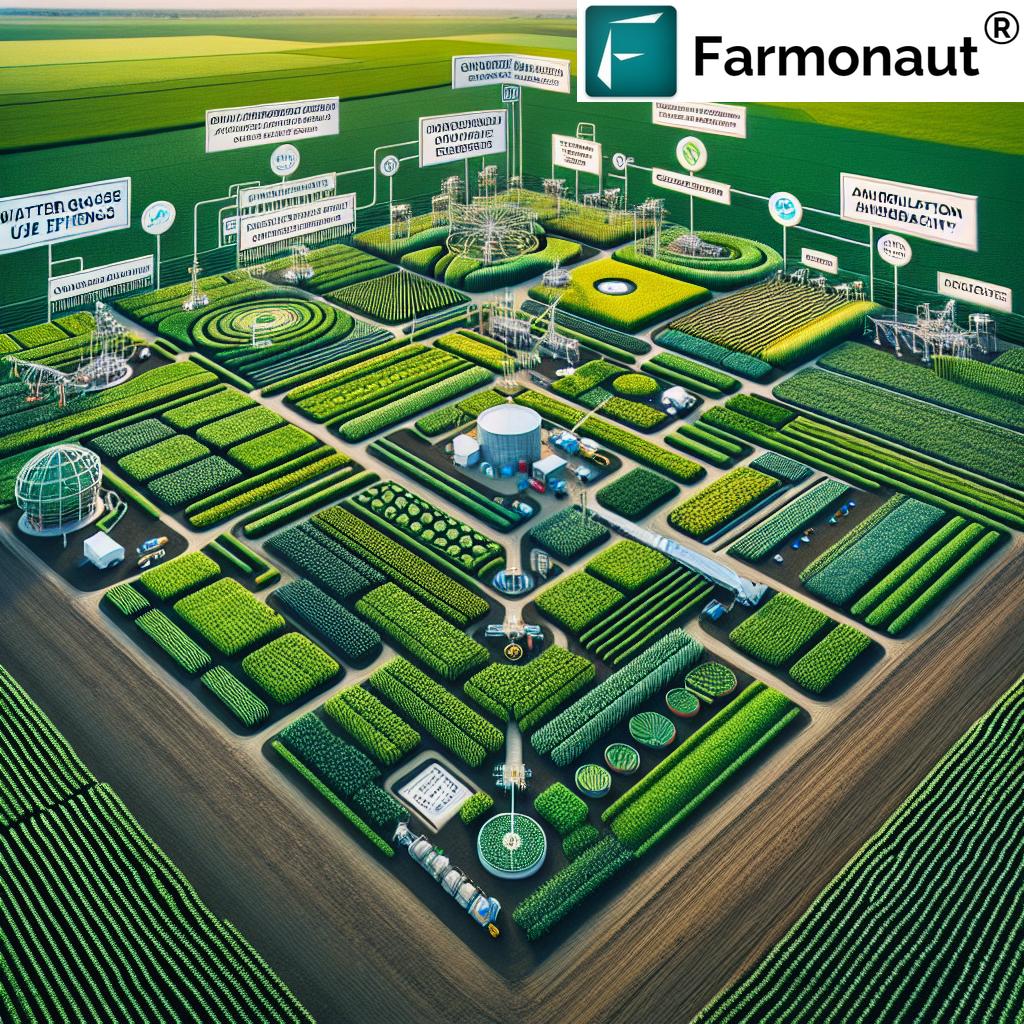Sorghum Sustainability: 7 Greenhouse Gas Benefits Under California’s New Regulations
“California’s new greenhouse gas rules could reduce sorghum-related emissions by up to 30% by 2030.”
“Sorghum cultivation emits 40% less greenhouse gases per acre compared to traditional cereal crops under new sustainability standards.”
Context: Sorghum, California, and New Greenhouse Gas Regulations
Sustainability in agriculture is no longer a niche concern—today, it’s central to how we grow, process, and sell our food and feed crops. As we assess the sorghum crop sustainability, ongoing legislative changes like the California greenhouse gas regulations draw our collective attention onto every stage of the agriculture supply chain emissions process.
With the passing of Senate Bills 253 and 261, California is yet again setting the bar for environmental compliance. While these greenhouse gas reporting rules might seem focused inward on California, the reality is that their impact stretches across the country, touching fields in Kansas, Texas, and beyond.
The golden state’s approach requires a rethinking not only of compliance but also of how crops—especially sustainability champions like sorghum—can help both growers and companies meet the expectations of the new laws.
The New Rules: California’s Greenhouse Gas Reporting Regulations
Let’s first break down what these new crop compliance laws California mean for all of us in the agriculture industry, whether we’re operating fields, managing grain, or simply selling food products into the expansive California market.
What Are Senate Bills 253 and 261?
- SB 253: Requires companies doing business in California to publicly disclose all greenhouse gas emissions—Scope 1, 2, and 3.
- SB 261: Mandates reporting of all climate-related financial risks by companies.
These laws go far beyond local businesses. Because Scope 3 emissions California include the upstream and downstream activities—think fertilizer production, irrigation, tillage practices, grain transportation, and end-product processing—the implications ripple all the way back to the farm.
What Are Scope 1, 2, and 3 Emissions?
- Scope 1: Direct emissions from sources owned or controlled by the company (farm equipment, on-field diesel use, etc.).
- Scope 2: Indirect emissions from purchased energy, such as electricity for irrigation or drying grain.
- Scope 3: All other indirect emissions—essentially, the entire supply chain and even how products are used and disposed of by consumers.
In practice, if a company in California is buying sorghum from a farmer in Kansas or Texas for use in food, fuel, or animal feed, they will need detailed emissions reporting all the way back to crop planting.
Key Questions Farmers Will Face:
- What kind of nitrogen fertilizer did you use?
- What were your tillage practices?
- How much irrigation water was applied?
- How much diesel was consumed during planting and harvest?
- What’s your crop’s carbon footprint per ton of grain?
These are no longer just “nice to know”—they’re compliance requirements.
Sorghum Sustainability in the Spotlight
As stakeholders navigating the evolving compliance landscape, we recognize that sorghum is uniquely positioned to shine under the new greenhouse gas rules for crops.
Our crop leverages naturally low input requirements, superior water efficiency, and reduced dependence on synthetic fertilizers, often resulting in a demonstrably smaller carbon footprint compared to corn, wheat, or rice. For companies searching for ways to reduce emissions on paper and in practice, sorghum represents an invaluable, sustainable solution.
Below, we delve into the compelling benefits of sorghum for lowering agricultural GHG emissions—all while explaining how these features intersect with California’s new emissions reporting requirements for farmers and the broader move toward sustainability in grain production.
Seven Greenhouse Gas Benefits of Sorghum
Let’s explore, in detail, the seven major greenhouse gas benefits that put sorghum front-and-center in the climate action conversation for modern agriculture.
-
Lower Nitrogen Fertilizer Requirements and Emissions
Sorghum’s biological efficiency allows it to use less nitrogen per bushel produced than most other grains. Less nitrogen means lower nitrous oxide (N₂O) emissions—a greenhouse gas with nearly 300 times the warming potential of CO₂.
- Sorghum farmers in Kansas, Texas, and similar U.S. regions report a consistent decrease in required fertilizer applications compared to corn, helping maintain compliance with new California greenhouse gas regulations.
- Reduced fertilizer input translates into less on-farm emissions (Scope 1), lower agriculture supply chain emissions (fertilizer manufacturing, Scope 3), and an improved sorghum carbon footprint for reporting.
Tip: To quantify and easily report these reductions, consider using Farmonaut’s carbon footprinting tool—designed to help both individual farmers and large agribusinesses with real-time emissions estimations and compliance documentation.
-
Superior Water Efficiency = Reduced Emissions
Sorghum’s drought tolerance is legendary. It often uses one-third less irrigation water than corn, with substantial implications for on-farm energy use and thus indirect emissions (Scope 2).
- Reduced irrigation means fewer hours of electric or diesel-powered pumps, slashing Scope 2 and 1 emissions respectively.
- Automatic compliance boost: Sorghum’s minimal water needs help companies and farms meet or exceed sustainability benchmarks set by new greenhouse gas rules for crops in California.
-
Low Tillage, High Soil Health
Sorghum is well-suited to conservation tillage or no-till practices—both of which keep carbon locked in the soil. This simultaneously reduces fuel use (and diesel-based emissions) while increasing soil carbon sequestration rates.
- Soil organic carbon benefits translate into actual carbon sequestration that can offset overall reported emissions.
- No-till sorghum operations decrease overall field passes, directly lowering harvest inputs and total farm-based GHG output.
-
Resilience: High Yields Under Marginal Inputs
Even with less water and fertilizer, sorghum yields remain consistent and competitive—giving it an edge in emissions-per-bushel or ton reporting. Sustainability in grain production is about “more with less”—and sorghum simply delivers.
- Low “yield penalty” means GHG savings are not merely theoretical, but actually achieved in commercial farming scenarios.
- Companies can confidently promote sorghum-based products as a sustainable, climate-friendly choice under current California greenhouse gas regulations.
-
Smaller Overall Carbon Footprint from Production to Market
Because input costs and emissions are reduced at every stage (fertilizer, irrigation, tillage, harvest), the final sorghum carbon footprint—Scope 1 through 3—is consistently lower than that of comparable grains.
- The entire downstream supply chain—from Kansas and Texas fields to California supermarkets—can document measurable emissions savings when sourcing sorghum grain.
- Easy integration into company reports: Lower GHG figures simplify compliance with emissions reporting requirements for farmers and buyers alike.
-
Enhanced Biodiversity and Reduced Chemical Inputs
Sorghum’s tolerance for tough conditions often means fewer pesticide and herbicide applications, translating to diminished manufacturing and transportation emissions (part of Scope 3 supply chain emissions).
- Healthier on-farm ecosystems support overall sustainability program targets—boosting both environmental and regulatory outcomes.
- Companies can leverage this for improved sustainability narratives and actual compliance performance in food products and whole-of-chain agriculture.
-
Future-Proof Compliance Under Greenhouse Gas Regulations
The real clincher? Sorghum is already achieving—and even surpassing—emissions reduction targets anticipated by California’s new state-level reporting laws.
- Fast-tracked regulatory compliance: Farms growing sorghum often require fewer adjustments to their methods, meaning lower costs associated with GHG tracking and reporting.
- Fewer outside consultants and expensive third-party verification schemes: Lower carbon footprint crops like sorghum ease the administrative and practical burdens brought on by new compliance requirements.
“California’s new greenhouse gas rules could reduce sorghum-related emissions by up to 30% by 2030.”
Farmonaut Technology: Supporting Sustainability & Compliance
How can we, as part of the agriculture and business community, manage the increasing costs associated with compliance but continue to move toward genuine sustainability? Here’s where Farmonaut’s technology platform makes the difference.
By leveraging advanced satellite data, artificial intelligence, and blockchain traceability, Farmonaut offers real-time, precise, and cost-effective solutions that simplify the documentation and validation required by the new California greenhouse gas regulations:
- Satellite-Based Monitoring: Verify crop health, soil moisture, and growth stages through multispectral satellite images—sharpening decisions on irrigation, fertilizer, and tillage for both yield and emissions savings.
- AI Advisory (Jeevn): Dynamic, personalized guidance for in-season decisions—optimizing resource management and reporting readiness.
- Carbon Footprinting Tool: Quantify your farm’s greenhouse gas output and sequestration potental with user-friendly dashboards, aligned with Scope 1, 2, and 3 reporting needs (details).
- Blockchain-Based Traceability: Guarantee secure, transparent records across the grain supply chain—a must-have for food companies facing climate risk disclosure under SB 261 (see Farmonaut Traceability).
- Fleet & Resource Management: Monitor, document, and optimize farm operations to minimize energy, diesel use, and operational emissions (Fleet Management Explained).
Mobile-, Web- and API-based access ensures every user—from individual farmers in the U.S. to large, multinational companies—can achieve consistent, easy compliance and sustainability performance.
Ready to get started? Try Farmonaut’s carbon footprinting solutions for grain and food crops to simplify Scope 3 reporting and regulatory documentation.
Comparative Greenhouse Gas Emissions Table
The following table compares greenhouse gas emissions of sorghum versus other major crops, focusing on the specific requirements emerging from the new crop compliance laws California. We also assess each crop’s carbon sequestration potential, ease of compliance, and overall sustainability under the forthcoming greenhouse gas reporting rules.
| Crop Type | Estimated GHG Emissions per Hectare (tons CO₂e/ha) | Change in Emissions with New Regulations (%) |
Carbon Sequestration Potential | Sustainability Rating | Regulatory Compliance Ease |
|---|---|---|---|---|---|
| Sorghum | 1.6 | ↓30% | High (via reduced tillage & enhanced soil carbon) | ★★★★★ | Easy |
| Corn | 2.7 | ↓17% | Moderate | ★★★☆☆ | Moderate |
| Wheat | 2.2 | ↓20% | High (if no-till) | ★★★★☆ | Moderate |
| Rice | 4.8 | ↓10% | Low (paddy methane production offsets gains) | ★★☆☆☆ | Difficult |
Estimated values are for reference only, based on leading agricultural GHG audit sources. “Change in Emissions” represents maximum projected reduction under compliance with California greenhouse gas regulations by 2030. Sustainability Rating and Compliance Ease reflect practical experience with on-farm management and anticipated paperwork burden.
Adapting Sorghum Production under New Agriculture Supply Chain Emissions Rules
What Must Farmers and Agribusinesses Do Next?
The new emissions reporting requirements for farmers are reshaping management strategies across sorghum country. Here’s how we can stay ahead:
- Document inputs precisely. Use digital tools for accurate tracking of nitrogen application, tillage practices, irrigation water, and energy/fuel use. This allows seamless Scope 1-3 emissions reporting and addresses both company and legal requirements.
-
Leverage technology for compliance and resource management.
Farmonaut’s crop health monitoring and resource management tools (see large-scale farm management) ensure you know exactly where you stand on resource use and emissions output. - Adopt climate-smart practices. Continue to prioritize no-till farming, limit excessive fertilizer use, and optimize water application—further improving your overall footprint.
- Provide chain-of-custody data. Blockchain-based traceability (see Farmonaut Traceability) offers secure, transparent input and output records aligned with SB 261 disclosure needs.
By adopting these best practices, every link in the grain supply chain can both comply with greenhouse gas rules for crops and actively support the move toward authentic sustainability in grain production.
Farmonaut: Tools for Adapting to Regulatory Requirements
-
Fleet Management
Track and optimize farm machinery for minimized diesel use (Scope 1 emissions), helping with energy efficiency and documentation. -
Crop Loan and Insurance
Use satellite-based data for fast, transparent verification—reducing the fraud risk in agricultural finance and keeping compliance audits smooth. -
Farmonaut Advisory Suite
From soil carbon to real-time resource monitoring—access the latest compliance and sustainability technology on all devices.
Costs and Opportunities: Impact of Regulations on Farming Costs
Any discussion around impact of regulations on farming costs must recognize that, for most farmers, new reporting requirements mean new data collection, administrative effort, and—sometimes—added fees for third-party verification. While many of us may view these as burdens, there are also real opportunities:
Biggest Cost Drivers:
- New compliance paperwork and reporting systems—especially for companies requesting field-level data from every grower in their supply chain.
- Verification costs—using consultants or specialized technologies to document compliance with each aspect of California’s greenhouse gas regulations.
- Potential changes in input purchasing behavior—as more companies choose to buy from growers offering low-carbon, fully documented crops.
But for many, the opportunity lies in adaptation:
- Sorghum’s natural sustainability advantages lower the cost of compliance. With less fuel, water, and fertilizer required, there is inherently less data to collect—and lower GHG numbers to declare.
- Digital record-keeping tools (like Farmonaut’s App) make compliance much less expensive and easier than using paper or generic spreadsheets.
- Companies focused on emissions may offer preferential contracts and stronger market access to farmers and businesses demonstrating documented low-footprint production.
Farmonaut’s App, API & Tools for Sorghum Compliance
What do we need to move forward—both as farmers and as companies navigating the sustainability expectations of the world’s fourth largest economy? The answer is easy access to real data and actionable insights.
- Farmonaut Web and Mobile App: Monitor in-field resource use, crop health, and emissions with ease. Try it now—track your sustainability data from desktop or smartphone.
- API Connectivity: Integrate Farmonaut API (see Developer Docs) with in-house company or farm management software for automated reporting at scale.
- Secure, Scalable System: Farmonaut solutions are affordable—even for individual farmers—and scalable for agribusiness, government, and finance institutions.
For businesses focused on compliance: Farmonaut Traceability can secure your grain’s journey from farm to market, ensuring every party in the chain can verify sustainability credentials and meet state emissions regulations.
Need emissions, satellite, or weather data integrated with your existing platform?
Explore Farmonaut API and check Developer Docs.
FAQ: Sorghum, Sustainability, and California’s Climate Regulations
These laws require any company selling in California to report their grain’s footprint—including everything from fertilizer use to diesel burned in Kansas, Texas, or elsewhere. If you sell to companies in this supply chain, you’ll be asked for emissions and resource data, regardless of your own farm’s location.
Q2: Which crops benefit most from a sustainability standpoint in the new rules?
Sorghum is a top performer thanks to its naturally low input needs, minimal GHG emissions, and efficient water use. Compliance paperwork and emissions reductions are both easier with sorghum compared to corn or rice.
Q3: Are there financial incentives for meeting the new requirements?
Currently, there are no mandatory premiums for “green” sorghum in California. However, companies may prioritize sourcing from lower-carbon suppliers to ease their reporting obligations and reduce compliance risk, indirectly improving marketing and contract opportunities for compliant growers.
Q4: What is the most efficient way to report and verify emissions?
The best option is to use satellite and AI-enabled platforms (like the Farmonaut app) to automatically track, calculate, and create downloadable reports suitable for company and regulatory requests.
Q5: What’s the biggest area for improvement for sorghum farmers facing these new laws?
Proactive digital data management, especially around nitrogen use, tillage practices, and irrigation water applied, will offer the single greatest benefit—for both compliance and sustainability performance.
Conclusion: See Sorghum as a Solution
We may all be subject to increasing “red tape,” but as a sector, we also have real agency. By centering sorghum crop sustainability in our approach, we do more than tick off compliance boxes—we set new standards for climate-smart, efficient, and future-proof grain production.
The requirements emerging from California greenhouse gas regulations don’t have to be a hurdle. With the right data and strategies—like those enabled by the advanced, affordable tools offered by Farmonaut—we can confidently report emissions, optimize our resource inputs, and lead the way toward a sustainable food future.
Let’s make sustainability not just an obligation, but an opportunity—for our farms, our businesses, and our planet.














